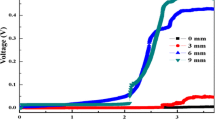Abstract
A single chamber stackable microbial fuel cell (SCS-MFC) comprising four MFC units was developed. When operated separately, each unit generated a volumetric power density (Pmax,V) of 26.2 W/m3 at 5.8 mA or 475 mV. The total columbic efficiency was 40% for each unit. Parallel connection of four units produced the same level of power output (Pmax,V of 22.8 W/m3 at 27 mA), which was approximately four times higher than a single unit alone. Series connection of four units, however, only generated a maximum power output of 14.7 W/m3 at 730 mV, which was less than the expected value. This energy loss appeared to be caused by lateral current flow between two units, particularly in the middle of the system. The cathode was found to be the major limiting factor in our system. Compared to the stacked operation of multiple separate MFCs, our single chamber reactor does not require a delicate water distribution system and thus is more easily implemented in pre-existing wastewater treatment facilities with serpentine flow paths, such as fixed-bed reactors, with minimal infrastructure changes.




Similar content being viewed by others
Reference
Aelterman P, Rabaey K, Pham HT, Boon N, Verstraete W (2006) Continuous electricity generation at high voltages and currents using stacked microbial fuel cells. Environ Sci Technol 40:3388–3394
He Z, Minteer S, Angenent LT (2005) Electricity generation from artificial wastewater using an upflow microbial fuel cell. Environ Sci Technol 39:5262–5267
Leadbetter JR, Breznak JA (1996) Physiological ecology of Methanobrevibacter cuticularis sp. nov. and Methanobrevibacter curvatus sp. nov., isolated from the hindgut of the termite Reticulitermes flavipes. Appl Environ Microbiol 62:3620–3631
Liu H, Logan BE (2005) Electricity generation using an air-cathode single chamber microbial fuel cell in the presence and absence of a proton exchange membrane. Environ Sci Technol 38:4040–4046
Logan BE, Hamelers B, Rozendal R, Schrorder U, Keller J, Freguia S, Aelterman P, Verstraete W, Rabaey K (2006) Microbial fuel cells: methodology and technology. Environ Sci Technol 40:5181–5192
Lowy D, Tender LM, Zeikus JG, Park D, Lovley DR (2006) Harvesting energy from the marine sediment-water interface II—kinetic activity of anode materials. Biosens Bioelec 21:2058–2063
Min B, Kim JR, Oh SE, Regan JM, Logan BE (2005) Electricity generation from swine wastewater using microbial fuel cells. Water Res 39:4961–4968
Rabaey K, Verstraete W (2005) Microbial fuel cells: novel biotechnology for energy generation. Trends in Biotechnology 23:291–298
Ryan OH, Tibor F, Sang-Joon L, Fritz BP (2003) Lateral ionic conduction in planar array fuel cells. J Electrochem Soc 150:A430–A438
Shimoyama T, Komukai S, Yamazawa A, Ueno Y, Logan BE, Watanabe K (2008) Electricity generation from model organic wastewater in a cassette-electrode microbial fuel cell. Appl Microbiol Biotechnol 80:325–330
Soderberg JN, Co AC, Sirk AHC, Birss VI (2006) Impact of porous electrode properties on the electrochemical transfer coefficient. J Phys Chem 110:10401–10410
Thomassen M, Sandnes E, Børresen B, Tunold R (2006) Evaluation of concepts for hydrogen–chlorine fuel cells. J Appl Electrochem 36:813–819
Acknowledgment
This work was funded by a startup grant at Rensselaer Polytechnic Institute.
Author information
Authors and Affiliations
Corresponding author
Rights and permissions
About this article
Cite this article
Wang, B., Han, JI. A single chamber stackable microbial fuel cell with air cathode. Biotechnol Lett 31, 387–393 (2009). https://doi.org/10.1007/s10529-008-9877-0
Received:
Revised:
Accepted:
Published:
Issue Date:
DOI: https://doi.org/10.1007/s10529-008-9877-0




